
Metal baking pans are typically reserved for baking cakes or casseroles, but there's no reason you can't use one to cook chicken. Metal pans are tough and durable, and you can clean them up with a scouring pad. Bone-in chicken takes a bit longer to cook than boneless chicken, but it usually has more flavor. Check it frequently so you don't overcook it, though, which causes dryness.
Benefits
Metal baking pans have several advantages when you're cooking bone-in chicken. These pans are widely available and economical, so you probably have one lurking in your kitchen. They're lightweight and they heat up quickly, so chicken cooks quickly. Unless you're using a nonstick metal pan, bits of the chicken will stick to the pan's surface. These tasty bits make delicious gravy and sauces when deglazed.
Drawbacks
Stainless steel and steel baking pans heat up quickly and stay hot, but they don't heat evenly, meaning that some parts of the chicken might cook more quickly than others. If you use a metal baking pan, check the chicken frequently and, if cooking pieces, move them or turn them over to ensure even browning. Some types of metal pans -- including aluminum, copper, iron and steel pans -- are reactive, meaning they form a reaction with certain types of foods. If you cook the chicken with an acidic ingredient such as tomatoes, lemon juice or wine, you may notice a metallic or "off" flavor in the chicken.
Method
To cook bone-in chicken pieces in a metal baking pan, spread the chicken on the pan with at least 1/2 inch of space between each piece. Season the chicken well. If you want a poached or braised chicken, add a little chicken broth to the pan and cover with foil. If you want a roasted effect, cook the chicken dry at high heat and watch it carefully. Brushing the chicken with olive oil enhances the browning effect. To roast a whole chicken in a metal baking pan, set a roasting rack or cooking rack in the pan to elevate the bird slightly from the drippings. This elevated position is what gives roasted chicken its crisp, golden skin.
Details
Dark, anodized pans tend to cook food more quickly than regular metal pans. If you have this type of pan, lower the heat by 25 degrees. If you're using convection cooking, you'll get better results with a shallow pan, as opposed to a pan with high sides. In convection cooking, air circulates over and around the food to brown and cook it. The hot air can't reach food as effectively in a deep pan.
Related Articles
Roast Chicken in Enameled Cast Iron
How to Cook Chicken Pieces in an ...
How to Cook in Tabletop Convection Ovens
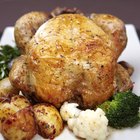
How to Smoke a Chicken in the Oven

How to Cook Chicken Bratwurst
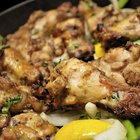
How to Broil Chicken on the Bone
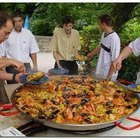
What is a Paella Pan?

How to Cook Thick Pork Chops in the ...
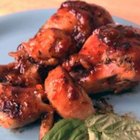
Baked BBQ Chicken Recipe

How to Make Blackened Chicken
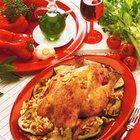
What Are Chicken Drippings?
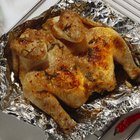
How to Cook a Chicken in a Toaster Oven ...

How to Cook a Flat Chicken
Can You Cook Frozen Chicken?

Difference Between Fryer & Roaster ...
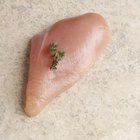
How to Cook Sauteed Chicken With White ...

How to Cook a Thin Breaded Chicken ...
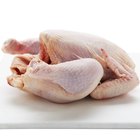
If Chicken Smells Bad Can You Still ...

How to Defrost a Chicken in a ...

What Is a Braising Pan?
References
Writer Bio
Julie Christensen is a food writer, caterer, and mom-chef. She's the creator of MarmaladeMom.org, dedicated to family fun and delicious food, and released a book titled "More Than Pot Roast: Fast, Fresh Slow Cooker Recipes."
Photo Credits
Jupiterimages/Comstock/Getty Images